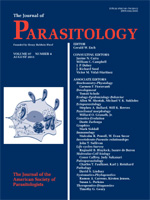Helisoma spp. snails are not susceptible to infection with miracidia of Schistosoma mansoni because the miracidia do not penetrate them. However, in view of the phylogenetic proximity and histocompatibility between Helisoma spp. and the normal intermediate host, Biomphalaria glabrata, schistosome miracidia conceivably could survive if experimentally introduced into the hemocoel of Helisoma spp. To test this hypothesis, schistosome-susceptible NIH albino B. glabrata, schistosome-resistant Salvador B. glabrata, and Helisoma duryi were injected with miracidia of S. mansoni, and the outcome was followed both by monitoring snails for infection for several weeks and by histological examination at 24 and 48 hr post-injection (PI). Patent infections developed in most NIH albino snails but in none of the Salvador B. glabrata or H. duryi individuals. Histological analysis showed a higher proportion of normal sporocysts in various tissues of NIH albino snails at both time periods relative to Salvador snails, which contained mostly sporocysts undergoing hemocytic encapsulation. In H. duryi, nearly all sporocysts were dead by 48 hr PI.
How to translate text using browser tools
1 August 2011
Incompatibility Between Miracidia of Schistosoma mansoni and Helisoma duryi Occurs at Two Stages: Penetration and Intramolluscan Establishment
John T. Sullivan,
John T. Yeung
ACCESS THE FULL ARTICLE

Journal of Parasitology
Vol. 97 • No. 4
August 2011
Vol. 97 • No. 4
August 2011




